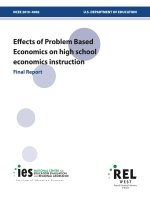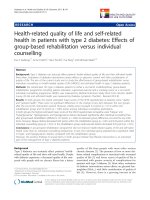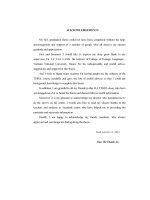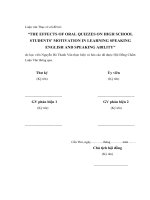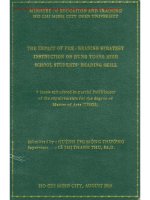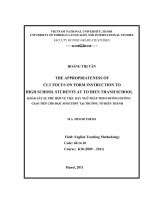Differentiated effects of reformulation versus reconstruction task on EFL high school students writing performance within the context of genre based instruction a thesis submitted in parti
Bạn đang xem bản rút gọn của tài liệu. Xem và tải ngay bản đầy đủ của tài liệu tại đây (2.88 MB, 197 trang )
.
CERTIFICATE OF ORIGINALITY
I certify my authorship of the thesis submitted today entitled:
DIFFERENTIATED EFFECTS OF REFORMULATION VERSUS
RECONSTRUCTION TASKS ON EFL STUDENTS’ WRITING
PERFORMANCE
in terms of the statement of the Requirements for the Theses in Master’s Program issued
by the Higher Degree Committee. The thesis has not been submitted for the award of any
degree or diploma in any other institutions.
Ho Chi Minh City, September 2016
NGUYỄN THỊ NGỌC CHÂU
i
RETENTION AND USE OF THE THESIS
I hereby state that I, Nguyen Thi Ngoc Chau, being the candidate for the degree of Master
of TESOL, accept the requirements of the University relating to the retention and use of
Master’s Thesis deposited in the Library.
In terms of these conditions, I agree that the original of my thesis deposited in the Library
should be accessible for purposes of study and research, in accordance with the normal
conditions established by the Library for the care, loan or reproduction of thesis.
Ho Chi Minh City, September 2016
NGUYỄN THỊ NGỌC CHÂU
ii
ACKNOWLEDGEMENTS
The author wishes to express her sincere appreciation and gratitude to those who have
advised and assisted throughout this research project.
First of all, I send my greatest gratitude to my supervisor, Dr. Nguyen Thu Huong, for his
encouragement and guidance throughout the research. I owe him for his resources and
time reading the drafts, helping with the statistical analyses of the data as well as
discussing the results with me. His kind support, explanation, and comments have
encouraged me to complete this project. Without his excellent academic guidance and
support, my thesis would not have been possible.
Secondly, I would like to extend my sincere gratitude to all lecturers in the Ho Chi Minh
City Open University who provided me with invaluable sources of knowledge during my
study there and all the staff members of the Department of Post Graduate Studies for their
help during the course. Especially, I would like to express my great thanks to Dr. Pham
Vu Phi Ho as a devoted counsellor for my class TESOL7 whose advice, support and
encouragement are significant to us.
Thirdly, I am very grateful to the Board of Directors of Nguyen Quang Dieu Gifted High
School for creating all the best conditions for me to take this MA course and finish the
thesis.
Also, I would like to thank all of my English-majored students from Cohort 4, who took
part in this research, for their great efforts to complete various tests and questionnaires.
This thesis would not have been completed without their outstanding cooperation.
iii
I also would like to acknowledge my colleagues and friends who directly or indirectly
contributed to my thesis. My deep gratitude goes to Mr. Nguyen Dang Hoang Duy, for
his invaluable supports in sharing the challenges at work so that I could devote time to
completing the thesis. I owe my thanks to Mr. Nguyen Dang Hoang Duy, Mr. Le Xuan
Ho, Ms. Mai Hong Ngoc who helped me with grading the post-tests.
Finally, I wish to express my heartfelt thanks to my parents, family members whose
prayers, love and best wishes were a source of inspiration, encouragement and motivation
for me as I was successfully completing this study.
iv
ABSTRACT
Written communication is an issue that EFL teachers have to address within the setting of
internationalization. Genre-based writing instruction has been suggested after some
inadequacies have been found concerning the product and process-based approach to
writing teaching. Different methods of genre-based writing instruction have been
introduced; however, few studies have focused on the effects of the application of
reformulation and reconstruction tasks. An experimental study was attempted to find out
the differentiated impacts of the two types of tasks on EFL high school students’ writing
performance on their attitudes to writing in the light of genre-based writing instruction.
A single group of students with a stratification of three levels of proficiency were
conveniently selected to join two phases of the study. The reformulation tasks were
introduced in Phase 2, experimental time while reconstruction tasks were implemented in
the control time in Phase 1. The quantitative data from the pretest and the post-test of the
two phases were analyzed to find out whether or not students made progress over ten
weeks in their writing ability. Also, the qualitative data acquired from a questionnairebased survey after the treatment and students’ written feedback were considered to get
more insights into the extent of confidence and challenge experienced by the students
when the tasks were applied. The study shed light into the role of noticing in introducing
the different aspects of discourse types (genres) in teaching writing to high school
students.
v
TABLE OF CONTENT
CERTIFICATE OF ORIGINALITY ................................................................................... i
RETENTION AND USE OF THE THESIS ....................................................................... ii
ACKNOWLEDGEMENTS................................................................................................ iii
ABSTRACT ........................................................................................................................ v
LIST OF TABLES, CHARTS AND FIGURES ............................................................... xii
LIST OF ABBREVIATIONS .......................................................................................... xiv
CHAPTER 1: INTRODUCTION ........................................................................................ 1
1.1. Background of the Problem ...................................................................................... 1
1.1.1. An overview of writing approaches proposed by theorists and practitioners .... 1
1.1.2. Writing Teaching and Curriculum in the Study Setting .................................... 4
1.2. Aims of the Study ..................................................................................................... 6
1.3. Research Questions ................................................................................................... 7
1.4. Research Hypothesis ................................................................................................. 7
1.5. Significance of the Study .......................................................................................... 8
1.6. Organization of the Study ......................................................................................... 8
1.7. Definition of Terms................................................................................................... 9
CHAPTER 2: LITERATURE REVIEW........................................................................... 10
2.1. Views and Trends in Teaching Writing ................................................................. 10
2.2. Writing Approaches in the History of L2 Composition Teaching ......................... 11
2.2.1. Product approach .............................................................................................. 11
2.2.2. Process approach .............................................................................................. 12
2.2.3. Genre-based approach ..................................................................................... 15
2.2.3.1. The concept of genre in the SFL view ....................................................... 15
2.2.3.2. The properties of three approaches to genre ............................................. 16
2.2.3.3. Characteristics of genre properties ............................................................. 18
vi
2.2.3.4. The positive and negative sides of the genre-based approach ................... 20
2.3. A comparison of writing approaches ...................................................................... 20
2.4. Reconstruction and Reformulation. ....................................................................... 23
2.4.1. Reconstruction.................................................................................................. 23
2.4.2. Reformulation .................................................................................................. 24
2.4.3. Properties of “Focus on Form” ( RF) and Focus on Forms (RC) ................... 25
2.4.4. Studies on RC and RF ..................................................................................... 26
2.4.5. Explicit and Implicit Instruction ...................................................................... 30
2.4.5.1. A distinction between implicit and explicit instruction ............................. 30
2.4.5.2. An overview of formal instruction from previous studies ......................... 31
2.4.5.3. The correlation among implicit and explicit instruction, implicit and
explicit learning, implicit and explicit knowledge .................................................. 33
2.5. The genre-based approach applied in the study ...................................................... 35
2.5.1. Writing teaching in the study setting ............................................................... 35
2.5.2. The Sydney School applied in the study setting .............................................. 35
2.5.3. The argumentative essays in the study............................................................. 38
2.5.4. The application of genre-based approach to teaching English writing at the
study setting ............................................................................................................... 39
2.6. The conceptual framework ..................................................................................... 40
2.7. Chapter summary .................................................................................................... 42
CHAPTER 3: METHODOLOGY ..................................................................................... 43
3.1. Research Design...................................................................................................... 43
3.2. Research Site ........................................................................................................... 43
3.3. Teaching Materials.................................................................................................. 44
3.4. Research Participants .............................................................................................. 44
3.5. Data Types and Methods of data collection............................................................ 45
3.5.1. Experiment ....................................................................................................... 45
3.5.2. Tests ................................................................................................................. 46
vii
3.5.2.1. Proficiency test ........................................................................................... 46
3.5.2.2. Writing post-test 1 and post-test 2.............................................................. 46
3.5.3. Journals ............................................................................................................ 47
3.5. 4. Questionnaires ................................................................................................. 47
3.5. 5. Reliability of the questionnaire ....................................................................... 49
3.6. Experimental teaching process ............................................................................... 50
3.6.1. Pre-treatment stage ........................................................................................... 52
3.6.2 Treatment stage ................................................................................................. 52
3.6.21. Reconstruction ............................................................................................. 52
3.6.2.2. Reformulation............................................................................................. 52
3.6.2.3. Speaking-writing activities ........................................................................ 53
3.6.3. Post-treatment stage ......................................................................................... 54
3.6.4. A comparison between RC’ s and RF’ s procedures ...................................... 54
3.7. Data collection ........................................................................................................ 56
3.8. Methods of analysis ................................................................................................ 56
3.8.1 Descriptive values ............................................................................................. 57
3.8.1.1 Frequency (f) ............................................................................................... 57
3.8.1.2 Percentage (%) ............................................................................................ 57
3.8.1.3. Mean ........................................................................................................... 57
3.8.1.4. Standard deviation (S.D.) ........................................................................... 58
3.8.1.5. Bivariate Correlation .................................................................................. 58
3.8.2. Analysis of students’ essays.............................................................................. 58
3.8.3 Descriptive data analysis of post-tests .............................................................. 59
3.8.4. Descriptive data analysis of questionnaire ...................................................... 60
3.8.5. Textual analysis of journals ............................................................................. 60
3.9. Scoring criteria ........................................................................................................ 62
3.9.1. Scoring for the OPT ......................................................................................... 62
viii
3.9.2. Scoring for writing post-tests ........................................................................... 62
3.10. Chapter summary .................................................................................................. 63
CHAPTER 4: DATA ANALYSIS AND INTERPRETATION ....................................... 64
4.1. Results in the writing tests ...................................................................................... 64
4.1.1. Statistical analysis of test results among the three groups ............................... 64
4.1.1.1. Statistical analysis on group High level during Post-test 1 and Post-test2. 65
4.1.1.2. Statistical analysis on group Middle level during Post-test 1 and Post-test2.
................................................................................................................................. 66
4.1.1.3. Statistical analysis on group Low level during Post-test 1 and Post-test2. 67
4.1.1.4. Statistical analysis of test results among the three groups ......................... 68
4.1.2. Statistical analysis of writing abilities among three groups............................. 70
4.1.2.1. High level group ......................................................................................... 70
4.1.2.2. Middle level group ..................................................................................... 71
4.1.2.3. Low level group.......................................................................................... 72
4.1.2.4. Statistical analyses on three groups’ writing abilities after three tests....... 72
4.2. Results on the relationship between language proficiency and writing
performance ................................................................................................................... 78
4.3. Results from journals and questionnaire ................................................................. 81
4.3.1. Participants’ background .................................................................................. 82
4.3.2. Students’ attitudes toward RC and RF ............................................................. 83
4.3.3. Students’ affection, confidence and challenges on RC phase.......................... 84
4.3.3.1. Students’ keenness and confidence on RC phase....................................... 84
4.3.3. 2. Students’ anxiety and challenges on RC phase ......................................... 86
4.3.4. Students’ affection, confidence and challenges on RF phase .......................... 88
4.3.4.1. Students’ keenness on RF phase ................................................................ 88
4.3.4.2. Students’ confidence on RF phase ............................................................. 89
ix
4.3.4.3. Students’ anxiety and challenges on RF phase ......................................... 90
4.3.5. Reasons for students’ priority in Reconstruction phase ................................... 93
4.3.6. Reasons for students’ priority in Reformulation phase .................................... 94
4.4. Chapter summary .................................................................................................... 97
CHAPTER 5: DISCUSSION OF THE FINDINGS .......................................................... 98
5.1. Findings on research questions ............................................................................... 98
5.1.1. Students’ writing achievement ......................................................................... 98
5.1.2. The relationship between language proficiency and writing performance ...... 99
5.1.3. Students’ reflection on the innovation ............................................................. 99
5.2. Findings on writing notification to teaching writing ............................................ 103
5.2.1. The “ visibility” of the sample essays in RF tasks ......................................... 103
5.2.2. The role of implicitness in RF tasks............................................................... 103
5.3. Findings on the innovative roles ........................................................................... 104
5.3.1. New teaching approach .................................................................................. 105
5.3.2. New teacher’s role.......................................................................................... 105
5.3.3. New learners’ role and opportunity ............................................................... 106
5.3.4. New curriculum designer’s role ..................................................................... 107
5.4. Chapter summary .................................................................................................. 107
CHAPTER 6: CONCLUSIONS, LIMITATIONS AND RECOMMENDATIONS....... 108
6.1. Summary of key findings ......................................................................................... 108
6.2. Implications........................................................................................................... 109
6.3. Limitations ............................................................................................................ 111
6.4. Recommendations for further research ................................................................. 112
6.5 Chapter summary ................................................................................................... 112
REFERENCE .................................................................................................................. 114
APPENDIX 1: MARKING SCALE FOR GRADERS’ EVALUATION....................... 119
APPENDIX 2: A SUMMARY OF WRITING TASKS AND GENRES INVOLVED . 122
APPENDIX 3A: PROFICIENCY TEST......................................................................... 124
APPENDIX 3B: PROFICIENCY TEST SCORES ......................................................... 132
x
APPENDIX 4A: POST-TEST 1 ...................................................................................... 133
APPENDIX 4B: SCORES OF POST-TEST 1 ................................................................ 133
APPENDIX 4B: POST-TEST 2 ...................................................................................... 134
APPENDIX 4B: SCORES OF POST-TEST 2 ................................................................ 134
APPENDIX 5A: POST-TEST ESSAYS FROM HG...................................................... 136
APPENDIX 5B: POST-TESTS FROM MG ................................................................... 141
APPENDIX 5C: POST-TESTS FROM LG .................................................................... 146
APPENDIX 6A: (ENGLISH VERSION) ...................................................................... 152
APPENDIX 6B: (VIETNAMESE VERSION) ............................................................... 159
APPENDIX 7: THE RECAST ........................................................................................ 166
APPENDIX 8: IN-CLASS WRITING ............................................................................ 167
APPENDIX 9: CLASSROOM HANDOUTS ................................................................. 168
xi
LIST OF TABLES, CHARTS AND FIGURES
TABLES
Table 2.4.5.1: Imlicit and explicit instruction………………………………………… 27
Table 2.4.5.2b: Some characteristics of formal instruction …………………………...29
Table 2.4.5.3: Typical tasks for investigating two types of learning ………………... 30
Table 3.4: Group Attribution according to proficiency test scores…………………… 41
Table 3.8a: Structure and aim of the questionaire…………………………………… . 50
Table 3.9b: Description of Reliability Statistics of the Questionnaire……………… .. 51
Table 3.13.2: Writing scores in the study…………………………………………… .. 58
Table 4.1.1.1.a: High level group statistics of three test results…………………… . 60
Table 4.1.1.2a: Description of test scores from Middle level among three tests… .... 61
Table 4.1.1.3.a. Description of test scores from Low level among two tests…… .... 62
Table 4.1.1.4a: Description of test results among three groups……………………… 63
Table 4.1.2.1.Description of writing abilities in High-proficiency Group………
65
Table 4.1.2.2: Description of writing abilities in Middle level Group……………… .. 66
Table 4.1.2.3: Description of writing abilities in Low level Group………………… .. 66
Table 4.1.2.4: Summary of the table and chart on three groups’ writing abilities after
three tests …………………………………………………………………………… .. 67
Table 4.1.2.10: Correlations on the relationship between port-test 1 and post-test 2… 71
Table 4.2.1: Pearson correlation coefficient results between proficiency and post-test 2
........................................................................................................................................ 73
Table 4.2.2: Spearman correlation coefficient results between proficiency and post-test
2……………………………………………………………………………………… . 73
Table 4.2.3: Skewness correlation coefficient results between proficiency and post-test
2……………………………………………………………………………………… . 74
Table 4.3.1. Students’ extra classes………………………………………………… ... 77
Table 4.3.2.a: Students’ preference for RC and RF………………………………….. 77
Table 4.3.2.b. Students’ affection, confidence and anxiety towards RC and RF…… .. 78
xii
Table 4.3.3.1a: Students’ keenness on RC…………………………………………… 80
Table 4.4.3.1b: Students’confidence on RC………………………………………… 80
Table 4.3.3.2: Students’ anxiety and challenges on RC phase……………………… .. 81
Table 4.3.4.1. Students’ keeness on RF phase………………………………………... 83
Table 4.3.4. 2. Students’ confidence on RF phase……………………………………. 84
Table 4.3.4.3. Students’ anxiety and challenges on RF phase……………………… 85
Table 4.3.5: Reasons for Reconstruction phase………………………………………. 87
Table 4.3.6: Reasons for Reformulation phase………………………………………. 89
Table 4.3.7: Students’ feedback and recommendation on RC and RF……………… .. 90
FIGURES
Figure 2.2.2: The process wheel proposed by Harmer ……………………………… 12
Figure 2.4.5.2a: Types of formal instruction ………………………………………… 28
Figure 2.5.2: Demonstration of Teaching and learning cycle ……………………… .. 34
Figure 2.6: The conceptual framework……………………………………………….. 37
Figure 3.6.2.3: The Discussion Clock ……………………………………………… .. 46
Figure 4.1.1.1.b: High-proficiency group’s writing scores between two post-tests… .. 61
Figure 4.1.1.2b: Middle-proficiency group’s writing scores between two post-tests… 62
Figure 4.1.1.3b: Low-proficiency group’s writing scores between two post-tests…… 63
Figure 4.1.1.4.b: Summary of students’ achievement among three groups ………… . 64
Figure 4.2.4:Scattergram showing relationships between proficiency and post-test 2
........................................................................................................................................ 75
Figure 4.2.5: Scattergram showing groups’ performance at proficiency test……… 75
Figure 4.2.6: Scattergram showing groups’ performance at post-test 2…………… 76
CHARTS
Chart 4.1.2.5. Improvements of content ……………………………………………… 68
Chart 4.1.2.6. Improvements of organization ……………………………………… ... 69
Chart 4.1.2.7. Improvement of vocabulary ………………………………………… 69
Chart 4.1.2.8. Improvement of language use ………………………………………… 70
Chart 4.1.2.9. Improvements of mechanics………………………………………… . 71
xiii
LIST OF ABBREVIATIONS
CEFR
: Common European Framework Reference
EAP
: English for Academic Purpose
EFL
: English as a Foreign Language
ELT
: English Language Teaching
ESA
: Engage-Study- Activate
ESP
: English for Specific Purpose
FFI
: Form-focused instruction
L1
: First language
L2
: Second language
LG
: Low-proficiency group
M
: Mean
MA
: Master of Arts
MOET
: Ministry of Education and Training
MG
: Mid-proficiency group
HG
: High-proficiency group
OPT
: Oxford Placement Test
RC
: Reconstruction
RF
: Reformulation
SD
: Standard Deviation
SFL
: Systemic Functional Linguistics
SPSS
: Statistical Package for Social Sciences
WTO
: World Trade Organization
xiv
CHAPTER 1: INTRODUCTION
Sir Francis Bacon, in the Essays or Counsels Civil & Moral of Francis Bacon (1625)
wrote, “ Reading makes a full man; Conference a ready man and Writing an exact man”.
Writing is in deed an essential skill for students of English as a Second Language (ESL)
and English as a Foreign Language ( EFL), which is not restricted to a particular age
group. Also, writing proves its pivotal role not only in school curriculum, in currently
required examination but also in real life. Writing in high school curriculum is regarded
as one of the four required language skills so as to serve as a foundation for acquiring
English competence in tertiary education. To meet the requirement of written
communication in the setting of internationalization and globalization, high school
teachers in Vietnamese context have applied lots of writing approaches proposed by
theorists and practitioners. However, the effectiveness of writing approaches in
Vietnamese context has not been distinctly confirmed so far. Similarly, students in
Nguyen Quang Dieu gifted high school have often encountered such difficulties as idea
development, organization and other writing problems though they have been presented
plenty of linguistic knowledge and experienced various writing approaches. This reason
has incited the researcher to get involved in the study to seek for the application of the
innovation tasks in writing teaching which might respond the satisfaction of learners’
needs and expectation.
1.1. Background of the Problem
1.1.1. An overview of writing approaches proposed by theorists and practitioners
The two last decades witnessed the major changes in the teaching of writing. The three
major movements were brought out to meet the new requirements: “ Focus on Form”, “
Focus on the writer” and “ Focus on the reader” (Tribble, 2006, p.44 ) and lots of studies
were done to shed some light on writing practicality. Both process approach and genre
1
orientation seem to prioritize learners’ awareness of the nature of writing and basic
principles of writing situation (Matsuo & Bevan, 2012). Anderson (1993) states that
genre-awareness is a prerequisite for “successful written communication” (as cited in
Matsuo & Bevan, 2012) and the outmoded that “writing =grammar/ translation” has been
defeated by the fact that successful writing requires “both rhetorical structure and control
of grammar” (Hyland, 2009, p.64). The researchers firmly conclude that learners’
management towards genre-consciousness, forms and strategies, is a “means to
empowerment” (Matsuo & Bevan, 2012). It cannot be denied that genre approach has
proved itself a promising and a popular approach, together with process approach, it is
believed to provide students with the knowledge about the nature of writing as well as the
social and cultural contexts and the constraints of the writing context.
In the teaching context of Vietnam, how widespread and significant any improvements in
writing instruction are is not yet clear. In reality, it is somehow similar to what HampLyons & Heasly (2006) states “the skill has, however, been “the last language skill to be
acquired … for foreign/ second language learners” ( p.2). Writing is a solo and an
important skill for writers to convey their messages to readers, yet whether or not the
messages might be effectively understood is entirely based on how they organized and
infused readers with their thoughts and spirit. This is indeed a challenge to English as a
Foreign Language (EFL) teachers and learners who have been facing with “the rhetorical
conventions of English texts” (Yan, 2005). They are required to grasp and manage the
differences between the structure, style, and organization in writing English and those in
their mother tongue. The Vietnamese writing teaching context has highlighted the
challenge of writing since there are many language-focused writing classes that focus on
“ exam-orientation purpose” rather than “the purposes of plurality of real readers outside
classroom context” (Luu, 2011, p.1471). It is widely known that school leavers still
possess an insufficient awareness of writing nature and the social and cultural contexts
and constraints in which writing takes place (Matsuo & Bevan, 2012 ). From the reality
of teaching writing skills in Vietnamese high school context where EFL students
2
apprehend plenty of linguistic knowledge but achieve little practical performance –
students have struggled with assigned “normally have to write about what is assigned by
their teacher rather than about what bears much relevance to them.” (Luu, 2010, p.81).
Luu (2011) firmly states that the majority of writing teachers just concentrate on
supplying students with vocabulary connected to the required topic and some questions to
“ help them shape ideas into the completed paragraphs” (p.1471). The researcher
acknowledges “Teaching writing in this way only benefits them to an extent that it can
assist them in producing the error-free texts following the models of correct language.
However, it does not contribute to help students realize and master such features as
purposes, audiences, context and linguistic conventions of text which are the important
features of any text-types”. Hoang (2007) also reports that the Vietnamese common
routine of instruction and practice is purely product-oriented approach through which
students are required to read the given instruction, think it over and write. As a matter of
fact, towards product-oriented writing teaching in Vietnam, the evaluation is merely
based on the knowledge of linguistic features according to “a set of conventions largely
derived from samples or model of a certain genre” (Ly, 2007 ).
In addition, Ellis (1996) observes that language teaching principles that emphasize
processes are a whole new experience for Vietnamese EFL teachers. Also, Tran (2001;
as cited in Ly, 2007), mentions writing as an activity performed by individuals with the
teacher-sole audience and students-quiet performers. It cannot be denied that their
reticence might be traced back to not only teachers’ ignorance of writing as a process,
but also the reality that they have not helped students to recognize the social conventions
of a certain genre that need to be met in order to successfully communicate through their
writing. The lack of sufficient linguistic input and writing characteristics required in
these genres has resulted in a superficial display of ideas which fails to meet the
expectation of readers. Students may gradually have low motivation in learning to write ,
which makes it harder and harder to enhance writing skills.
3
Apart from changes of writing practicality, the two last decades also witnessed the
innovation and requirement in the teaching and learning this skill in our country. The
challenges and opportunities from economic reforms in 1996, the 1994 degree issued by
the Vietnamese Prime Minister for an intermediate level of English proficiency for all
government officers and WTO membership in 2006 made English in Vietnam much more
important than ever before (Ton and Pham, 2010) . That is to say, the blossom of
innovations in English teaching and learning in the light of Common European
Framework Reference (CEFR). One example is the English Project 2020 of Ministry of
Education which strongly mentions the role of high school education in developing
students’ language competence. In terms of writing tests, EFL high school leavers are
expected to achieve the competence of Pre-Intermediate (Level B1 in CEFR) so that they
can easily adjust themselves to the demands of using English in integration era. Actually,
learners’ competence in English for both academic purposes and daily communication is
powered up by the educational setting. The last decade also witnessed lots of changes in
teaching English in Vietnam in terms of exhortations from MOET, new teaching
textbooks and innovations in teaching methodology and writing instruction is not an
exception. That is to say, the notion of writing closely linked to grammar and translation
has been disillusioned by innovations in writing instructions. However, how widespread
or substantial the changes in writing instructions has not been clearly proven.
With such demands for academic purposes and the reality of the contemporary teaching
of writing, how are teachers of writing ever going to gauge the effectiveness of current
writing approaches to scaffold students’ writing performance? This is also the
researcher’s long-nurtured theme after thirteen years working at high school context and
four teaching years at the research site.
1.1.2. Writing Teaching and Curriculum in the Study Setting
Nguyen Quang Dieu is a five-year-old gifted high school in the center of Cao Lanh city,
Dong Thap province. Like other Vietnamese schools to the English Project 2020 of the
4
Ministry of Education (MOET), its mission is to enhance students’ language competence.
In reality, the 11th-form textbook or Tieng Anh 11 in both curricula is presented with a
focus on many text-genres such as recounts, narratives, discussions, expository essays,
information reports, letter writings, etc. Those who join English-major classes are much
more involved in training English in comparison with their counterparts in other classes.
Though writing curriculum is officially prescribed by the Ministry of Education, the
selection of textbook for English class is up to school authority. In order to meet the
learners’ need and the requirement of gifted education, books from international
publishers are officially selected together with supplementary materials for preintermediate level.
Actually, genre-based approach introduced in these books has interested the researcher
for the last two years. Nevertheless, she is still uneasy about students’ performance from
the reality. Students have not completely made progress in writing skills though they
have acquired lots of forms, lexical and grammatical rules. The mini conference with
students at the beginning and at the end of each semester reveal that students always
harbor a dream about improving their writing skills and feel an “ invisible pressure” from
imitating a model text in the first stage of a writing class and such challenges in writing
as the appropriate style, idea development and time constraint.
The role of the model text and how to fix common challenges in writing can be seen in
the tasks of “focus on form” and “ focus on forms”. Reformulation which was first
proposed by Levenston (1978) and reconstruction introduced by Corder (1971) seem to
be promising in the case since reformulation is effective in noticing stimulation and tasks
providing to engage learners (Swain & Lapkin, 2002). Long (1983, as cited in Ellis,
1994) states that learners’ levels of proficiency supported by formal instructions are
much higher than those who do not since the counter-productive instructions of focus on
form leads to faster learning. However, Montogomery and Eistenstein (1985, as cited in
Ellis, 1994) propose that “form-oriented” should be combined with “ meaning-oriented”
5
to benefit students’ learning instead of using the former alone. The prior studies also
reveal various trends and opinion in writing approaches and Vietnamese writing
instructions are not exceptional. Despite the fact that reconstruction and reformulation
tasks hold the potential scaffolding, the feasibility of the two tasks have not been proven
in Vietnamese teaching context and no research have been conducted. In one word, the
continuing deficits of writing instruction and the reality of teaching writing at the school
setting raise some questions in the researcher’s mind:
1. Which task in genre-based writing instruction is conducive to teaching
argumentative genre, reconstruction or reformulation?
2. What happens if students are freed from reading the model essay? Will they
better their writing attainment? Will such a release of ideas be effective in
argumentation writing?
3. Does the level of grammatical proficiency help much in improving writing
skills?
4. Does it really work if EFL high school students are exposed to life-related
topics in their daily life?
5. Is implicit instruction conducive to genre-based instruction in general and
essay training in particular? Which retains a long-term effect, explicit or
implicit instruction?
From my own perspective, I would like to put forth a study to implement the tasks to the
teaching of writing so as to help improve students’ performance as well as motivation in
class.
1.2. Aims of the Study
The thesis therefore aims at (1) investigating the impact of reformulation and
reconstruction tasks on EFL high school students’ writing ability within the context of
genre-based writing instruction, (2) examining the relationship between language
proficiency and writing performance in the research pool and (3) exploring students’
6
perspectives on the application of reformulation and reconstruction tasks in the study
setting.
1.3. Research Questions
The study was conducted to answer the ensuing questions:
1. Is there any difference in writing performance when executing the reconstruction
and the reformulation tasks in writing instruction?
2. Is there any correlation between proficiency and writing performance?
3. How do students perceive the effectiveness of the reformulation task stage?
(a). To what extent do they feel confident about reformulation task construction?
(b). To what extent do they have anxiety over reformulation task instruction
presented?
1.4. Research Hypothesis
Based on the basis of the research questions the five hypotheses are formulated as
follows:
- for the first question, it may be hypothesized that the students significantly
outperform during the reformulation stage in terms of writing performance. Likewise,
high-proficiency students will significantly outperform mid-proficiency and lowproficiency students in terms of idea development, organization, vocabulary, language
use and mechanics.
- for the second question, there should be a correlation between grammar
proficiency and writing ability, which means that a good knowledge of grammar helps
students perform well in writing.
- for the last question, with reference to learners’ view on RF and RC, there should be a
relationship between students’ perspectives and students’ performance. They are supposed to
express their anxiety and confidence on the two types of tasks. It is assumed that implicit
instruction is conducive to genre-based writing instruction and the “ real-world” genre
might help students in training argumentative essay.
7
1.5. Significance of the Study
The study is expected to be significant for both teachers and students involved in the
research site. Since writing is one of the two productive skills, a good ability of writing
not only helps students with their English learning and academic results but also enables
them to express and update themselves with latest changes in business, science and
profession. For the students, the study results may contribute to improve their writing
skills on argumentation as well as boost their confidence through tasks involved during
the study. For teachers, the study is an endeavor to have them share perspectives and
introduce an appropriate approach for teaching writing skill. Also, the study might help
consolidate the orientation of writing instruction in the setting of gifted high school
context. By and large, the study may be useful, informative and applicable to the research
site context.
1.6. Organization of the Study
The study consists of six chapter. Chapter 1 introduces the background of the study
which is followed by research aims, research questions, hypothesis, significance of the
study, and organization of the thesis. Chapter 2 gives a scholarly discussion of issues
related to the thesis which is specified by theoretical concepts and empirical studies and
the conceptual framework. Chapter 3 presents the research design and methodology
employed in the study in terms of the research site, research participant, research design,
instrument, procedures and methods of analysis. Chapter 4 is about the results of the
study from collected data of proficiency, post-tests and questionnaire and students’
journal. Chapter 5 is confined within the discussions of the findings and followed by
Chapter 6, an introduction of conclusions, implications, and recommendations for further
research as well as several limitations of the study.
8
1.7. Definition of Terms
For the sack of clarity, the following terms used in this study gives particular meanings as
explained below:
Reconstruction : a forms-focused approach and bottom-up process with explicit
instruction to focus on accuracy through three stages of Presentation-Practice-Production.
Reformulation: a form-focused and top-down process with implicit instruction to focus
on both accuracy and fluency through three stages of Composing-Recast-Revising
Recast: the reformulated and native-like text by teacher and the starting point for learners
to first expose and then reconstruct.
Explicit instruction: the instruction directed at enabling learners to achieve the rules
during the learning process.
Implicit instruction: the instruction directed at enabling learners to infer rules without
awareness.
EFL learner: The term EFL learner refers to those who learn English as a foreign
language.
Genre-based approach: The genre approach is more socially oriented and focuses on the
ways in which writers and texts need to interact with readers. In this approach, writing is
seen as an essentially social activity in which texts are written to do things, the
assumption being that if the reader cannot recognize the purpose of a text,
communication will not be successful (Tribble, 1996, p.37)
9
CHAPTER 2
LITERATURE REVIEW
As proposed in the previous chapter, reformulation and reconstruction tasks within genrebased approach can be fruitful alternative approaches in the present English writing
instruction situation at gifted high schools. The present chapter is aimed at providing a
theoretical framework as a basis for the study conceptual framework. Hence it first
attempts to clarify key terminologies embodied in the study. Then a brief review of past
and more recent literature relating to the issue will be systematically discussed in terms of
both achievements and shortcomings. Also, a review of theoretical concepts of three
schools of genre, reformulation, reconstruction and the relationship among them together
with implicit versus explicit teaching is mentioned in order to make a comparison and
contrast among their characteristics as well as fully understand how they work. The
researcher reassesses the writing context in which argumentative essay is a top priority.
Lastly, the conceptual framework is introduced as the lodestar of the study.
2.1. Views and Trends in Teaching Writing
In contrast to the traditional view which considered writing “ primarily a means of
recording speech even though it must be acknowledged as a secondary medium of
communication in its own right” (Morris 1996: 24), the viewpoint of regarding writing as
a communication skill and a complex process has appreciated new roles and positions of
writing in language teaching and learning. The notion of being “ a complex, cognitive
process that requires sustained effort over a considerable period of time” (Nunan 1999:
273) and “ writing in a second language is a worthwhile enterprise in and of itself” (
Weigle 2002). Similarly, Hyland (2003) acknowledges writing in the complexity of a
relationship triangle among such elements as the audience ( the writer, the reader), the
10
text and the context (reality). Writing, therefore, is no longer a means of speech learning
but a means of linguistic expression and communication.
The three most significant trends in teaching writing over the last 30 years are focusing
on the structures, focusing on the process and focusing on the genre. Such trends as
“Focus on Form”, “Focus on the writer” and “Focus on the reader” (Tribble, 2006, p.44 ).
The first two tendencies relatively highlight the emphasis on “format text units on
grammatical of a text” and paying attention to the writer as an “ independent producer of
text” (Hyland, 2003, p.3). Reader-focused trend, however, emphasizes “more on the
reader and on the convention that a piece of writing needs to follow in order to be
successfully accepted by its readership” (Muncie, 2002).
All writing-related issues mentioned above can be seen as fundamental background for
forming writing approaches in L2 composition teaching which are discussed one after
another in the following section.
2.2. Writing Approaches in the History of L2 Composition Teaching
2.2.1. Product approach
Product-based approach, the traditional one has been called by several names such as the
controlled-to-free approach, the text-based approach, and the guided composition
(Raimes, 1983; Silva, 1990; as cited in Tangpermpoon, 2008). According to Brown
(1994), the approach focuses on the final piece of writing by criteria measurement of
grammar, syntax, and mechanics (as cited in Yan, 2005). Badger and White (2000, p.
154) defines that product-based approach sees “ writing as mainly concerned with
knowledge about structure of language, and writing development as mainly the result of
the imitation of input, in the form of texts provided by the teacher”.
Obviously, the approach is deemed to be supportive to student writers, especially those
who are at low level of proficiency. Students are supported by knowledge of grammar,
11

